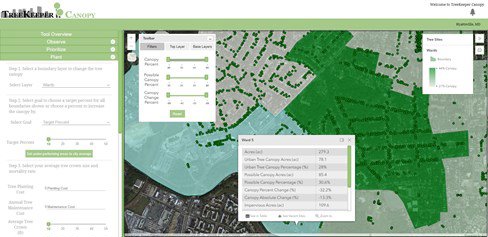
With the benefits of urban forests becoming a hot topic, setting tree canopy goals is rising in popularity among municipalities. But experienced urban foresters know that tree canopy goals can’t be met by coordinating dozens of planting programs alone—the right trees must be planted in the right place for the right reason.
Setting canopy goals does not always adequately take into account the existing canopy growth and loss. Therefore, many canopy goals are unrealistic. Before you can set a goal, you need to understand more than just how much canopy you have—you need to understand the dynamics that impact the growth and loss of trees.
So how can a community set a realistic tree canopy goal that creates a healthier and more equitable urban forest?
The Tools of the Trade
It takes a lot of work to estimate tree canopy coverage. Using dot grids on aerial photographs or using the tree basal area to come up with an estimated number can be difficult to calculate without yielding a credible result. Some online tools like i-Tree Canopy and i-Tree Landscape may provide answers faster, but the results are still estimates. For purposeful planting to be effective, knowing where trees are already located and needed is essential.
Software that visualizes canopy data can be an immense help to create and achieve tree canopy goals. TreeKeeper Canopy, Davey Resource Group, Inc.’s proprietary software, allows users to upload their tree inventory data, isolate specific data sets, find vacant planting spots, and create work orders to streamline plantings. Seeing data in action can create a deeper understanding of an urban forest.
But How Many Trees Are In My Urban Forest?
Some quick math can help determine this—estimate the upcoming losses from aging trees and subtract that from the number of trees currently planted to get an approximate number of trees in the canopy. Once that number is established, use it as your baseline and create a plan built around recovering those losses through purposeful planting.
The next question should be where to plant new trees. Ask around the community forestry industry and you’ll quickly discover that location is key for a successfully executed purposeful tree planting. Studies show that a person’s surroundings have more of an impact on their health than their genetics, including the number of trees in their area. Trees provide a number of mental and physical health benefits while decreasing a community’s carbon footprint. For the entire community to see those benefits, trees must be planted evenly throughout the area—a pillar of environmental justice.
A common first step to identifying tree planting locations is to conduct a tree inventory and use the inventory data to pinpoint vacant spots in the community. But going a step further and combining U.S. Census data with the inventory data can reveal details about the areas that lack canopy. Using these two data sets together to prioritize planting in lower-income areas with a higher minority population and low canopy coverage helps push equitable tree canopy goals forward.
To make sure planting locations are spots where trees can live their long lives; consider any planned development and plan tree species and location around it.
Calculating and analyzing a tree canopy can be a daunting task. Check out our webinar on purposeful plantings for helpful resources to create and meet tree canopy goals, or reach out to the Davey Resource Group team for expert assistance.



